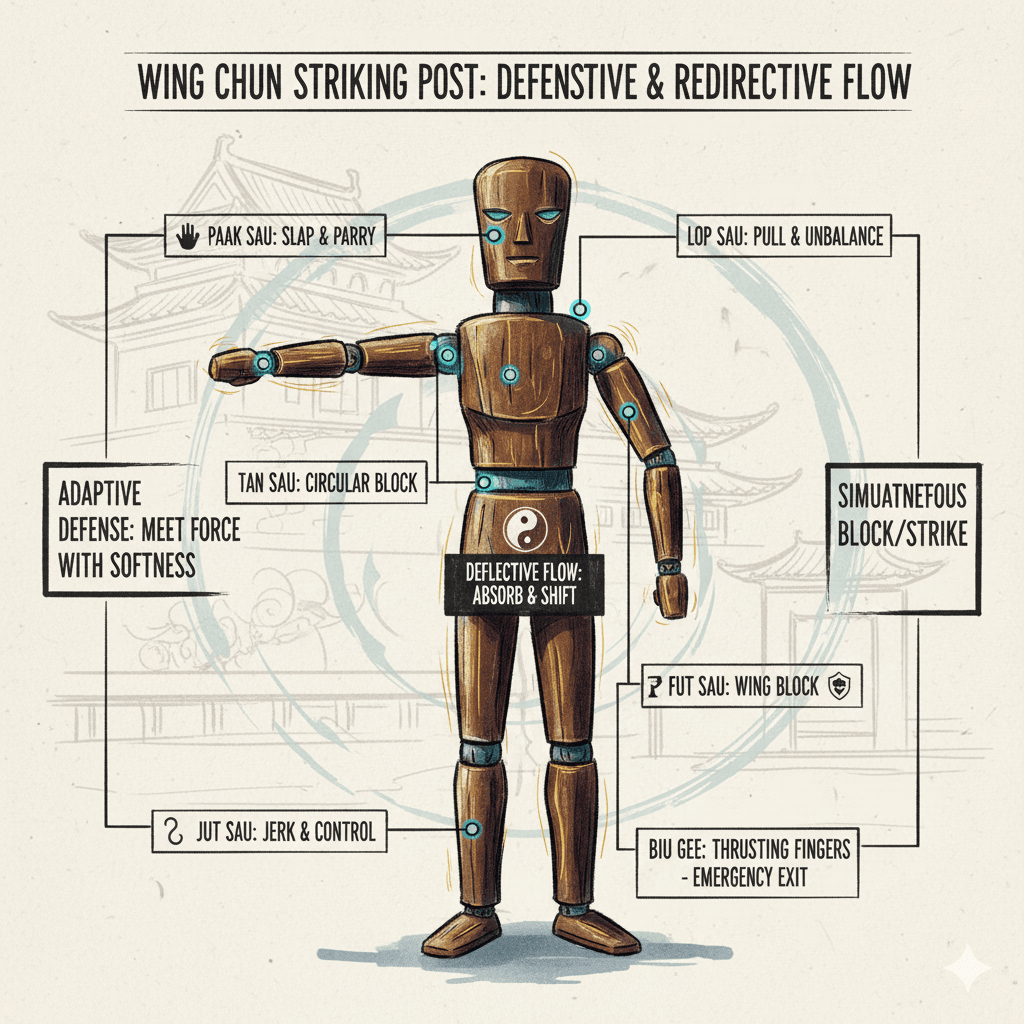Wing Chun, a martial art with deep historical roots, originated in Southern China during the 18th century.
It was created by a Buddhist nun named Ng Mui and is characterized by its emphasis on practicality, efficiency, and speed.
The philosophy behind Wing Chun places significant importance on striking accuracy, utilizing techniques that are designed to be direct and effective in close-range confrontations.
Unlike many traditional martial arts that rely on wide-ranging, powerful strikes, Wing Chun encourages practitioners to remain relaxed and fluid, which is essential for maximizing striking effectiveness.
At the core of Wing Chun is the principle of relaxation.
Practitioners are taught to maintain a state of calmness, thereby allowing the body to respond instinctively to threats.
This relaxed approach not only enhances mobility but also enables the fighter to conserve energy during prolonged engagements.
Efficient movement is another fundamental aspect of Wing Chun.
The art focuses on delivering strikes with minimal energy expenditure, allowing practitioners to maintain endurance while their opponents expend excess energy through ineffective, forceful attacks.
Directness is a hallmark of Wing Chun’s striking system.
Fighters are trained to close the distance between themselves and their opponents swiftly, employing techniques that are as straightforward as possible.
This approach minimizes the opportunity for opponents to evade or counterattack, thus improving the likelihood of successful strikes.
Effective striking in Wing Chun also relies heavily on proper stance, positioning, and balance.
The basic stance, known as the “Yee Jee Kim Yeung Ma” or “goat stance,” fosters stability and prepares practitioners for immediate action.
Positioning is equally crucial; fighters learn to angle their bodies correctly to maximize the impact of their strikes while maintaining a defensive posture.
Balance plays an integral role, as it allows for the transition between offense and defense fluidly, ensuring that strikes are not only powerful but also strategically advantageous.

Key Striking Techniques in Wing Chun
Wing Chun is renowned for its emphasis on precision and efficiency in striking techniques.
Among the cornerstone methods used by practitioners are the punch, palm strike, and various elbow strikes.
Each of these techniques has distinct mechanics and applications that are vital for effective combat.
The straight punch, often referred to as the “Chain Punch” in Wing Chun, is a primary striking technique characterized by its direct trajectory and rapid succession.
This technique leverages the body’s structure to deliver powerful strikes with minimal energy expenditure.
The mechanics involve a forward motion, utilizing the entire body to generate power rather than solely relying on the arm and shoulder.
Practitioners are instructed to maintain a relaxed hand and arm until the moment of impact, enhancing both speed and precision.
This approach maximizes the impact of each punch while minimizing the energy expended during execution.
Another crucial technique is the palm strike, which serves as both an offensive and defensive maneuver.
Unlike the conventional fist punch, the palm strike provides a broader surface area for contact, making it less likely to result in injury to the striker’s hand.
The mechanics of the palm strike entail a swift and controlled swinging motion, often used in close quarters to create space or disrupt an opponent’s attack.
This technique exemplifies Wing Chun’s philosophy of utilizing precision to effectively manage energy and maximize output in various combat scenarios.
Elbow strikes also play a significant role in Wing Chun, especially in close-range combat situations.
These strikes capitalize on the natural alignment of the body and are executed with a rotational motion that can generate tremendous force.

Videos are added as random thoughts 💭 💭 💭 💭 💭
Elbow strikes are particularly effective for countering attacks or closing the distance in a fight.
By mastering the mechanics of elbow strikes, practitioners can create openings for follow-up techniques, reinforcing the necessity of precision in each movement.
Overall, the significance of precision in these striking techniques cannot be overstated.
Mastering the mechanics of punches, palm strikes, and elbow strikes not only enhances effectiveness but also cultivates a deeper understanding of energy management within Wing Chun.
Emphasizing proper technique ultimately leads to a more impactful and efficient application of martial arts skills in combat.
Drills and Exercises for Improving Striking Accuracy
In the discipline of Wing Chun, improving striking accuracy is essential for effective application during practice and sparring.
A variety of drills and exercises can be implemented to achieve this goal. These drills not only enhance precision but also foster a deeper understanding of technique and timing.
One beneficial solo drill is the use of a striking pad or a target bag.
By focusing on specific target areas, practitioners can practice their punches, ensuring that each strike is both precise and powerful.
Regular use of this drill helps to develop muscle memory, which is crucial for accuracy over time.
Additionally, practitioners should incorporate shadow boxing into their routines, which allows for a focus on movement and form without the constraints of a partner.
During shadow boxing, one can visualize an opponent and work on accurate strikes while integrating footwork and evasive maneuvers.
Partner exercises are also vital for increasing striking accuracy.
Engaging in drills such as controlled exchanges enables practitioners to practice timing and distance.
For example, one partner can wear gloves while the other practices delivering punches to the target areas on their partner’s gloves.

This setup encourages the striking student to maintain accuracy in a dynamic environment.
Incorporating variability, such as different attack angles and rhythms, adds to the complexity of these drills, further enhancing precision.
To track progress in striking accuracy, practitioners may keep a log detailing the number of successful strikes versus attempts during each training session.
This technique not only provides a measurable outcome but also helps to identify areas for improvement.
As practitioners develop their skills, the integration of footwork and evasive maneuvers becomes increasingly important in ensuring that strikes can be delivered effectively in real situations.
With consistent practice of these exercises, striking accuracy will see significant enhancement.
Real-World Applications and Sparring Insights
Mastering accuracy in striking techniques is essential not only in the context of martial arts competitions but also in real-world self-defense situations.
Wing Chun emphasizes precision, allowing practitioners to respond effectively even under duress.
In various sparring sessions, students often encounter dynamic scenarios that compel them to adapt their striking techniques instantaneously, showcasing the significance of accuracy.
The efficiency of Wing Chun’s close-range combat techniques, such as the Chain Punch and the Bong Sau, is particularly observable in these contexts, where a well-placed strike can neutralize a threat rapidly.
Experienced practitioners frequently share personal anecdotes illustrating how precise striking techniques have played a pivotal role during sparring.
For instance, many have noted instances where they successfully employed Wing Chun’s unique footwork and angles to evade strikes while simultaneously delivering effective counters.
These encounters serve not only as a demonstration of skill but also as testimonials to the effectiveness of maintaining focus on accuracy even in high-pressure situations.
However, challenges in maintaining accuracy often arise during confrontational settings.
The stress and adrenaline associated with sparring can lead to rushed movements and a loss of technical form.
To address these hurdles, practitioners are encouraged to engage in controlled sparring environments and refine their techniques in a grounded manner.
Incorporating drills focused on rhythm and timing can help solidify the muscle memory required for precise execution.
Additionally, visualization techniques can be employed to mentally rehearse scenarios that might arise, enabling practitioners to remain composed and deliver accurate strikes when it matters most.
In conclusion, understanding the real-world applications of striking techniques within Wing Chun is crucial for both competitive and self-defense settings.
The effective integration of accuracy in striking forms the backbone of successful martial arts practice, empowering individuals to respond adeptly to a variety of confrontational situations.



